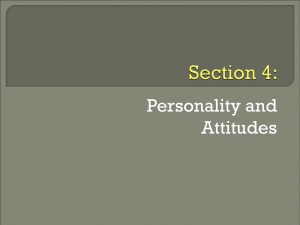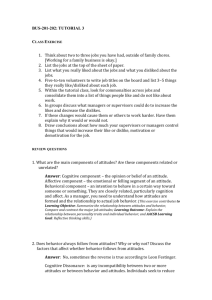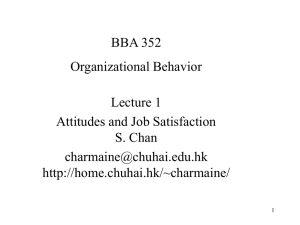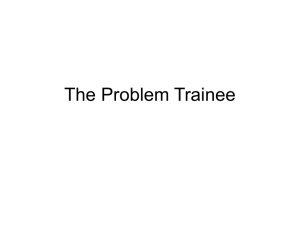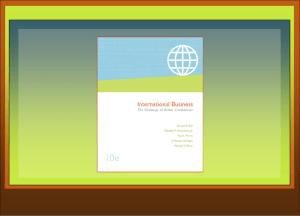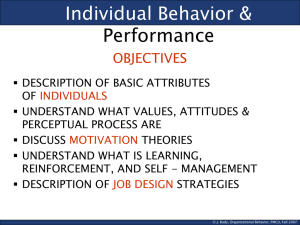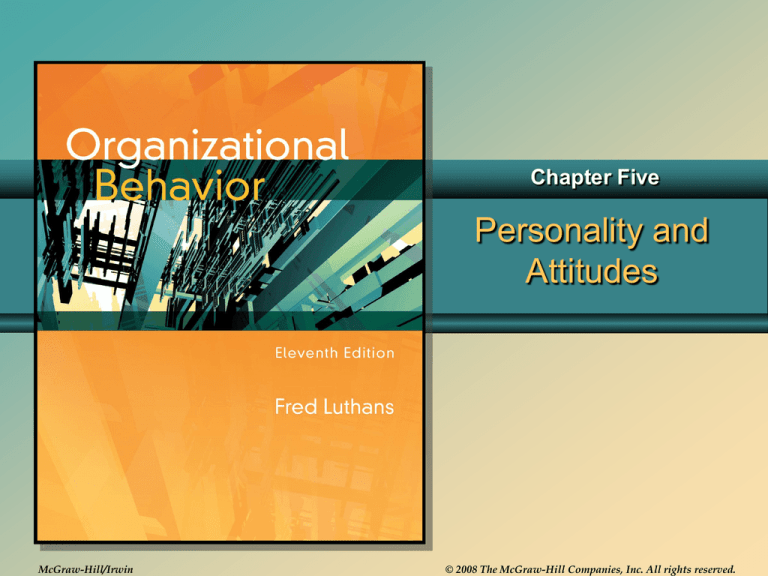
Chapter Five
Personality and
Attitudes
McGraw-Hill/Irwin
© 2008 The McGraw-Hill Companies, Inc. All rights reserved.
Learning Objectives
• Define the overall meaning of personality.
• Identify the “Big Five” personality traits and the
Myers-Briggs types.
• Describe the meaning of attitudes and their
emotional, informational, and behavioral
components.
• Explain the antecedents of work-related attitudes,
the functions they perform, and how they are
changed.
• Examine the major sources and outcomes of job
satisfaction, organizational commitment, and
prosocial, organizational citizenship behaviors.
Introduction
• Analysis of personality and attitudes is
vital to the study of organizational behavior
– A better understanding of cognitive, personal
variables of personality and attitudes
Meaning of Personality
• How people affect others
• How they understand and view
themselves
• Pattern of inner and outer measurable
traits
• Person-situation interaction
Role of Heredity and the Brain
• Major inroads are being made in the role
that genetics and the brain play both in
human behavior and personality
– Self-esteem
• People’s self-perceived competence and selfimage
– Person-situation interaction
• Understanding the human personality
Role of Heredity and the Brain
Continued
– Socialization process
• Continuous impact from the social environment
• Successful organizational socialization:
–
–
–
–
Provide a challenging first job
Provide relevant training
Provide timely and consistent feedback
Select a good first supervisor to be in charge of
socialization
– Design a relaxed orientation program
– Place new recruits in work groups with high morale
Role of Heredity and the Brain
Continued
• The “Big Five” personality traits
– Positive impact of conscientiousness
– Impact of the other traits
Myers-Briggs Type Indicator (MBTI)
Nature and Dimensions of Attitudes
• Characteristics of attitudes
– Tend to persist unless changed
– Fall along a continuum: favorable to
unfavorable
– Directed toward some object
• Components of attitudes
– Emotional
– Informational
– Behavioral
Nature and Dimensions of Attitudes
• Functions of attitudes
– Adjustment function – people to work
environment
– Ego-defensive function – defend self-image
– Value-expressive function – basic expression
of values
– Knowledge function – supply standards and
frames of reference
Nature and Dimensions of Attitudes
Continued
• Changing attitudes
– Barriers to changing attitudes
• Prior commitments
• Insufficient information
– Providing new information
• Overcome barriers and changes attitudes
– Use of Fear
• Instill fear to overcome barriers
Nature and Dimensions of Attitudes
Continued
• Changing attitudes (continued)
– Resolving discrepancies
• Between attitudes and behaviors
– Influence of friends or peers
• Use of persuasion
• Matter of personal interest
– Co-opting approach
• Involving people to work towards changing
dissatisfaction to satisfaction
Nature and Dimensions of Attitudes
Continued
• Antecedents of work-related attitudes:
– Attention given to affective dispositions
• Positive affectivity
• Negative affectivity
– Attention give to job satisfaction and
organizational commitment
Job Satisfaction
• Meaning of job satisfaction - Locke
– Involving cognitive, affective, and evaluative
reactions or attitudes
– A pleasurable or positive emotional state
resulting from the appraisal of one’s job or job
experience
Job Satisfaction
Continued
• Influences on job satisfaction
– The work itself
– Pay
– Promotions
– Supervision
– Work group
– Working conditions
Job Satisfaction
Continued
• Outcomes of job satisfaction
– Satisfaction and performance
• A positive relationship exists
– Satisfaction and turnover
• Unemployment rates do directly affect turnover
– Satisfaction and absenteeism
• A weak negative relationship
Job Satisfaction
Continued
• Outcomes of job satisfaction (continued)
– Other effects and ways to enhance
satisfaction
• Make jobs more fun
• Have fair pay, benefits, and promotion
opportunities
• Match people with jobs that fit their interest and
skills
• Design jobs to make them exciting and satisfying
Organizational Commitment
• Meaning of organizational commitment
– Strong desire to remain a member
– Willingness to exert high levels of effort
– Definite belief in, and acceptance of, the
values and goals
– Three-component model proposed by Meyer
and Allen:
• Affective commitment
• Continuance commitment
• Normative commitment
Organizational Commitment
Continued
• Outcomes of organizational commitment
– Deserve management attention
• Guidelines to enhance organizational
commitment
– Commit to people-first values
– Clarify and communicate your mission
– Guarantee organizational justice
– Create a sense of community
– Support employee development
Organizational Commitment
Continued
• Organizational citizenship behaviors
(OCBs)
– Major OCBs include:
•
•
•
•
•
Altruism
Conscientiousness
Civic virtue
Sportsmanship
Courtesy
Questions



